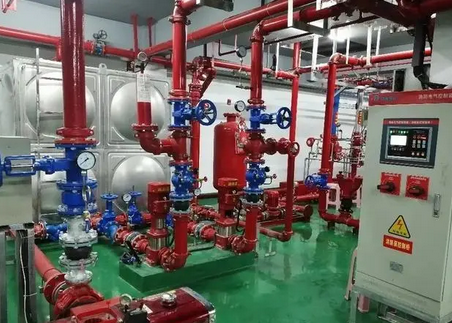Basic testing process of fire protection water supply system
The basic test process of the fire protection complete water supply system is a systematic and meticulous process, which aims to ensure that the system can operate normally and reliably under various circumstances.
1. System pressure test
Pressure test principle:
The system pressure test is carried out according to the principle of main pipe first, then trunk pipe, and then branch pipe.
The pipeline pressure test is carried out according to the system segment. Each area of the fire main pipe is a single unit, and each area of the fire sprinkler branch pipe basement is a single unit.
Pressure test preparation:
The concealed and buried pipelines should be tested for single hydraulic pressure before concealment.
After the pipeline system is installed, the overall hydraulic pressure test is carried out.
Before the segmented pressure test, the water supply point should be determined according to the site conditions. The drainage after the pressure test should be discharged in an organized manner and should not pollute other completed pipelines, equipment, etc.
Draw a pressure test system diagram first when testing the system, and set blind plates and discharge ports according to regulations.
Pressure test steps:
Test point setting: The test point of the hydraulic strength test is set at the lowest point of the pipe network.
Venting and pressure increase: The air in the pipe network should be exhausted first, and the pressure should be increased slowly.
Pressure stabilization inspection: After reaching the test pressure, the pressure drop of the fire water supply pipeline system under the test pressure within 10 minutes should not be greater than 0.02MPa, and then it is reduced to the working pressure for inspection. The pressure should remain unchanged without leakage.
2. Pipeline flushing
Flushing time:
After the pipeline pressure test is completed, flushing can be carried out.
Before the formal handover, flush continuously with municipal tap water.
Flushing order:
First outdoor, then indoor, first underground, then above ground.
The indoor pipe network is divided into several loops for flushing.
Flushing standard:
Observe the water outlet from the water tank and the pool outlet, and the turbidity, transparency, and color are basically consistent with the inlet water.

3. Equipment inspection and testing
Regulating valve and filter:
The filter screen of the regulating valve and filter and related instruments are installed after the pipeline pressure test and flushing.
During flushing, the water flow must not pass through all equipment, and the flushed pipes must be blocked in time to prevent dirt from entering.
Fire water tank:
Check whether the volume and elevation of the fire water tank meet the design requirements.
Fire pump:
Verify the number and water supply capacity of fire pump connectors, and conduct water supply test through mobile fire pump connectors to verify whether the water supply capacity can meet the design requirements.
When started manually or automatically, it should operate normally within 5 minutes. After the backup power supply is switched, the pump should be put into normal operation within 90 seconds.
Simulate the design start-up conditions, and the pressure-stabilizing pump should start immediately; when the system design pressure is reached, the pressure-stabilizing pump should stop running automatically.
Alarm system:
When water is released at the water test device, the alarm valve should be opened in time, and the delay should be 5~90s. The hydraulic alarm should sound an alarm. At the same time, the water flow indicator outputs an alarm signal, the pressure switch turns on the circuit to alarm, and the fire pump should be started.
After opening the system test valve, test the alarm system start-up time and the time required for water to flow to the outlet of the test device, which should meet the design requirements.
IV. Comprehensive test
System linkage test:
Put the sprinkler pump control cabinet in the automatic position, and then put the fire control cabinet in the automatic position.
Open the end water test device to conduct a water discharge test and observe the linkage of water flow indicators, system pressure switches, sprinkler pumps and other equipment.
Water pump coupler test:
It is best to ask a fire truck to assist in the test. Use the fire truck to inject water into the system pipe network through the coupler to test whether the coupler components are installed correctly and whether the pipe network is unobstructed.
If there is no fire truck, the fire hydrant can be connected to the sprinkler system coupler through a hose for testing.
Water curtain system test:
Fireproof cooling water curtain system: The test method can refer to the acceptance test method of the automatic sprinkler fire extinguishing system.
Fire separation water curtain system: Test according to specific design requirements.




